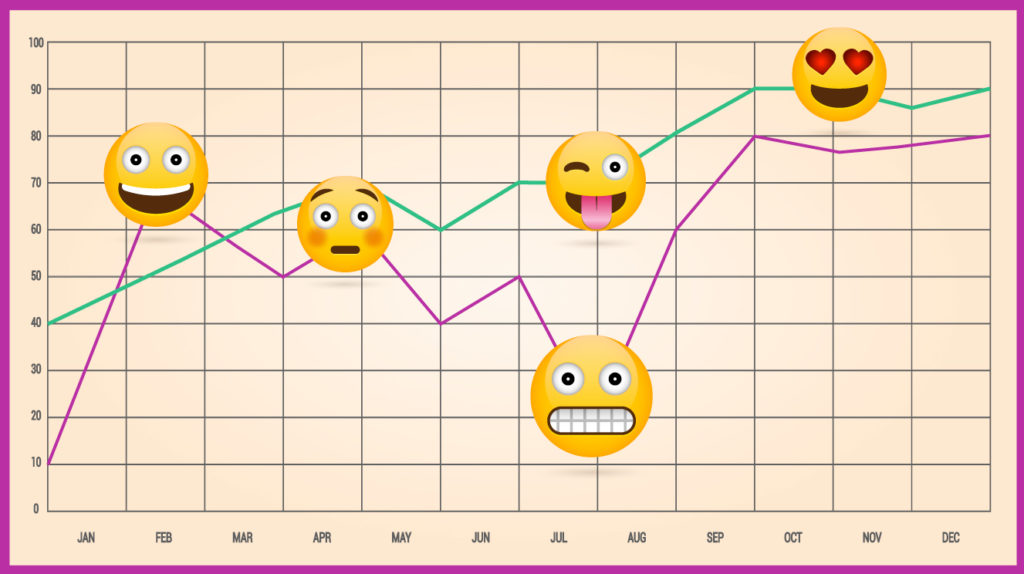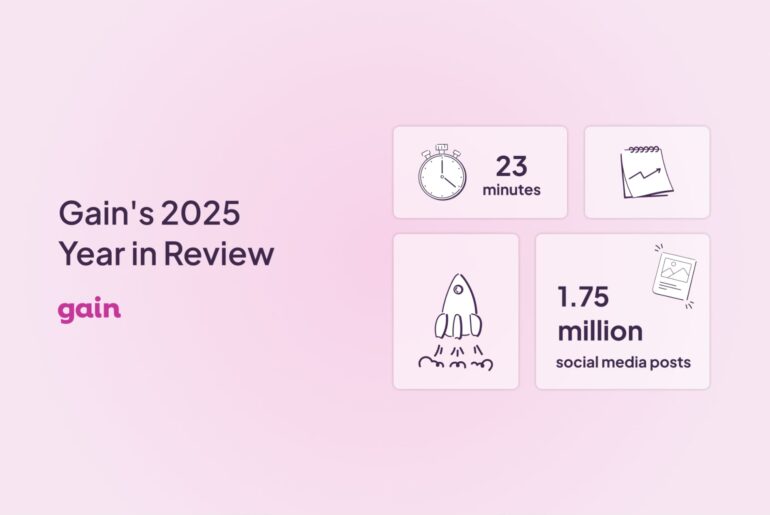“Currently 270 billion messages are sent per day and somewhere around 6 billion emojis are sent per day.”
– Christian Brucculeri, CEO of Snaps
Text messages alone can lack a lot of detail. In the most cases, the tone of text-based messages can be misinterpreted. The use of emojis fills in some of these informational gaps. Emojis can not only shed light on the tone of a message but also add some context to a point-of-view. Take a simple statement like, “I spent all my money on the latest iPhone,” and try adding a range of different emojis to the end of that sentence — happy, sad, angry, love — to see how the tone of the message is reshaped. Digital marketing efforts can be drastically shaped in much the same way with the incorporation of emojis. Not to mention, emojis can strengthen the customer-brand relationship. Emojis help people relate to each other in the digital landscape. For this reason, emojis have become such a key component of marketing messages with big brands eager to strengthen their relationship with younger audiences.
In the past, there was little assurance of ROI with emojis in marketing. Today, however, new measuring tools are able to collect not only basic figures, like the number of downloads or shares of emojis, but also the context certain emojis frequently appear and which demographics use them most often.
From branded emoji keyboards to emoji-based ad surveys, businesses now have plenty of ways to incorporate the colorful imagery and track its effect on their marketing campaigns.
Digital marketing efforts can be drastically shaped in much the same way with the incorporation of emojis. Not to mention, emojis can strengthen the customer-brand relationship. Emojis help people relate to each other in the digital landscape. For this reason, emojis have become such a key component of marketing messages with big brands eager to strengthen their relationship with younger audiences.
In the past, there was little assurance of ROI with emojis in marketing. Today, however, new measuring tools are able to collect not only basic figures, like the number of downloads or shares of emojis, but also the context certain emojis frequently appear and which demographics use them most often.
From branded emoji keyboards to emoji-based ad surveys, businesses now have plenty of ways to incorporate the colorful imagery and track its effect on their marketing campaigns.
The Growing Demand for Emojis
We know emojis are popular, but that isn’t the only incentive for brands to invest in emojis. Currently, there are a little under 2,000 available emojis, but a reported 75% of U.S. consumers have expressed an interest in receiving more branded emoji options. In fact, half of U.S. consumers would use a branded emoji as an alternative to messaging if given a choice. The individualized experience users enjoy in their text messaging apps only further feeds into this need for branded emojis. Rather than having a single emoji design for a dog, users would prefer to have various breeds; rather than a single beer emoji, users would prefer to use emojis of their favorite beer brands. Brands now have an open invitation to appear in the mobile messaging space, a space which marketing agencies previously, had limited ways of accessing with traditional advertising.
So just what are the options available for emoji-based advertising and what impact are they having? Let’s take at some of the latest measuring tools for emojis as well as some brands that have successfully tried these technologies out.
Brands now have an open invitation to appear in the mobile messaging space, a space which marketing agencies previously, had limited ways of accessing with traditional advertising.
So just what are the options available for emoji-based advertising and what impact are they having? Let’s take at some of the latest measuring tools for emojis as well as some brands that have successfully tried these technologies out.
Branded Emoji Downloads
 Branded emoji keyboards are nothing new to social media users. Celebrities as well as big name companies, like Taco Bell, have invested in branded emojis to further their customer engagement.
Taco Bell secured the creation of the taco emoji in 2014 after fans of the food chain voiced a desire for one.
Branded emoji keyboards are nothing new to social media users. Celebrities as well as big name companies, like Taco Bell, have invested in branded emojis to further their customer engagement.
Taco Bell secured the creation of the taco emoji in 2014 after fans of the food chain voiced a desire for one.
 The company capitalized on the taco emoji by creating an entire marketing campaign around its launch. The campaign, #TacoEmojiEngine, asked customers to tweet the taco emoji along with another emoji of their choice to receive a surprise mash-up GIF.
This campaign’s interactivity increased Taco Bell’s customer engagement and brand loyalty.
The company capitalized on the taco emoji by creating an entire marketing campaign around its launch. The campaign, #TacoEmojiEngine, asked customers to tweet the taco emoji along with another emoji of their choice to receive a surprise mash-up GIF.
This campaign’s interactivity increased Taco Bell’s customer engagement and brand loyalty.
 There are many services to create your own branded emojis and branded emoji keyboards. One of these services is Swyft, which creates branded emojis and stickers for download on iOS and Android devices. The company partners with numerous messaging apps, like Kik and Whatsapp, with which their keyboards are compatible.
Swyft provides an excellent example of what their campaigns can accomplish with a case study on the Carolina Hurricanes hockey team.
The team was looking to create buzz around their March 2016 Social Media Night event. They enlisted the help of Swyft to “emojify” some of the team’s star players, create Hurricane-themed reactions, as well as Hurricane logos and mascots.
There are many services to create your own branded emojis and branded emoji keyboards. One of these services is Swyft, which creates branded emojis and stickers for download on iOS and Android devices. The company partners with numerous messaging apps, like Kik and Whatsapp, with which their keyboards are compatible.
Swyft provides an excellent example of what their campaigns can accomplish with a case study on the Carolina Hurricanes hockey team.
The team was looking to create buzz around their March 2016 Social Media Night event. They enlisted the help of Swyft to “emojify” some of the team’s star players, create Hurricane-themed reactions, as well as Hurricane logos and mascots.
 Fans could download and share the emojis across virtually any messaging app or social platform, according to Swyft. The emoji campaign resulted in 13K+ shares on Social Media Night and over 50K + interactions in 24 hours.
Fans could download and share the emojis across virtually any messaging app or social platform, according to Swyft. The emoji campaign resulted in 13K+ shares on Social Media Night and over 50K + interactions in 24 hours.
Native Branded Emojis
Providing downloadable content, such as an emoji keyboard, is an excellent way to delve into the world of emojis. However, there is also the option for brands to provide customers with branded emojis without requiring any download. Machine technologies can detect and inject branded emojis within everyday digital chats. This inherent accessibility makes it a great way for brands looking for new seamless ways to interact with customers to do so. For example, a message to a friend “Hey, have you seen my running shoes?” would automatically generate branded emoji suggestions within the predictive texting bar. So if Nike and Adidas have native branded emojis, their emojis could automatically pop up as a suggestion for the texter to drop into their messages. Through advanced machine learning, the context of conversations is identified so brands can introduce their content natively. There is also no need for users to download a separate keyboard or any app for them to view the branded media. Companies like Smart Emoji and Emogi are just a few of the businesses offering these services. Tracking branded emojis with these services comes down to using location and demographic data to target particular target audiences. Advertisers are charged based on a cost-per-thousand-impression metric. Additionally, payments aren’t based on how many people utilize the branded emojis. Providing detailed information, like the context within which the emoji is shared, is collected so brands receive detailed insights into the preferences of their users. For example, a branded coffee cup emoji featured in a text message next to a smiley face is an indication of a happy client that the coffee brand should target during times when they have new offers or products.Emoji-based Ad Surveys
 Branded content isn’t the only way to incorporate emojis. They’ve also proven useful when featured in ad surveys. Emojis make expressing opinions very easy for customers, and they like the option to show a range of reactions.
Take it from Facebook who changed their “Like/Dislike” feature last year to offer Reaction Emojis instead. To accompany the range of reaction options, Facebook provides a Reactions API, so it’s easy for businesses to measure the performance of each reaction.
Not only are emojis expressive and fun to use, but they also help brands understand their target customers’ preferences in better detail. Emoji-based surveys give consumers a chance to rate an advertisement by choosing between emoji reactions – happy, neutral, or sad. This type of ad can help brands isolate possible leads – those that clicked the happy reaction – as well as identify the customers that should receive a different approach – those that clicked the sad reaction.
At GAIN, we utilize emoji-based surveys for all of our announcements. Any time we roll out an upgrade or new feature, our users get a pop-up notification about the upgrade. After reading the announcement, our users can tap an emoji to provide us with feedback and let us know what they think about the news.
Branded content isn’t the only way to incorporate emojis. They’ve also proven useful when featured in ad surveys. Emojis make expressing opinions very easy for customers, and they like the option to show a range of reactions.
Take it from Facebook who changed their “Like/Dislike” feature last year to offer Reaction Emojis instead. To accompany the range of reaction options, Facebook provides a Reactions API, so it’s easy for businesses to measure the performance of each reaction.
Not only are emojis expressive and fun to use, but they also help brands understand their target customers’ preferences in better detail. Emoji-based surveys give consumers a chance to rate an advertisement by choosing between emoji reactions – happy, neutral, or sad. This type of ad can help brands isolate possible leads – those that clicked the happy reaction – as well as identify the customers that should receive a different approach – those that clicked the sad reaction.
At GAIN, we utilize emoji-based surveys for all of our announcements. Any time we roll out an upgrade or new feature, our users get a pop-up notification about the upgrade. After reading the announcement, our users can tap an emoji to provide us with feedback and let us know what they think about the news.
 These emoji ratings have proven to be an effective way to understand the preferences of GAIN users in greater detail.
These types of survey-based campaigns come accompanied with detailed performance tracking analytics. Social media is the ideal location for these surveys, mainly because they provide a direct link to customer profile pages, making customer-brand engagement easy.
These emoji ratings have proven to be an effective way to understand the preferences of GAIN users in greater detail.
These types of survey-based campaigns come accompanied with detailed performance tracking analytics. Social media is the ideal location for these surveys, mainly because they provide a direct link to customer profile pages, making customer-brand engagement easy.
Going Forward with Emoji-based Marketing
 Notable brands adopting emojis as a marketing tool is nothing new, and the popularity of the trend shows no signs of slowing down. Research from Appboy found that emoji use is up 609% year-over-year. Now, with notable advances in tracking the performance of emojis, this marketing trend can provide brands across all industries with a solid way to track ROI.
If your brand is considering adopting emojis into your marketing campaign, start by answering these general questions:
Notable brands adopting emojis as a marketing tool is nothing new, and the popularity of the trend shows no signs of slowing down. Research from Appboy found that emoji use is up 609% year-over-year. Now, with notable advances in tracking the performance of emojis, this marketing trend can provide brands across all industries with a solid way to track ROI.
If your brand is considering adopting emojis into your marketing campaign, start by answering these general questions:
- In what ways does your customer base interact online?
- Do emojis align with your branding profile?
- Are their emoji-based marketing campaigns that would invite your target audience to collaborate directly with your brand?
 Emojis did not align with typical White House marketing campaigns, making their inclusion seem out of place and forced.
Emojis did not align with typical White House marketing campaigns, making their inclusion seem out of place and forced.
“Data needs to underpin everything brands are doing today. You can’t focus on trends blindly; it’s important to understand your demographic and then target them through means specifically tailored to them — whether it is emojis or anything else.”
– Nelson Freitas, chief strategy officer at Wunderman
So if your brand is ready to make the jump to emoji-based marketing, begin by answering the questions above to decide how and why emojis would be an asset to your marketing strategy.





